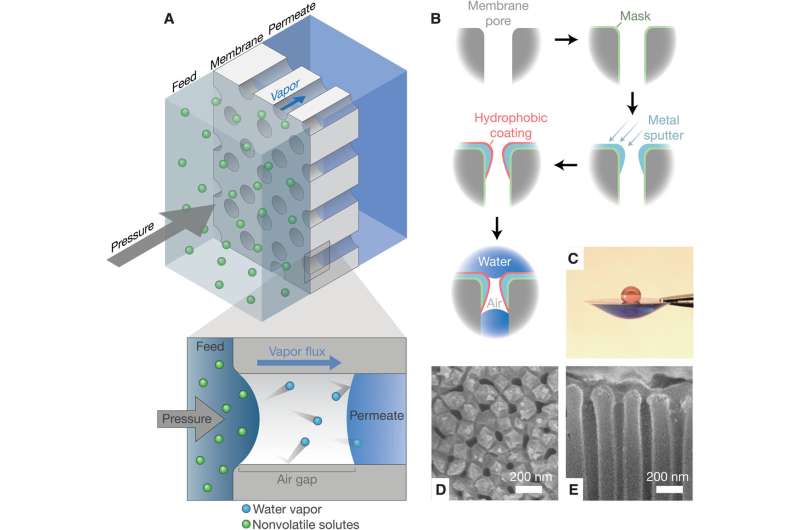
Design of ultrathin air-trapping membranes for pressure-driven vapor transport.(A) Schematic diagram of pressure-driven water vapor transport through a nanoporous membrane with an ultrathin air gap. (B) Schematic of the manufacturing process: A porous alumina membrane is modified with a hydrophilic masking layer, sputtered with controlled metal deposition into the pores, selectively coated with a hydrophobic layer on the surface of the metal, and treated to remove the remaining masking layer. (c) The water contact angle on the upper and lower parts of the membrane. SEM of (d) upper surface and (E) cross section of the upper surface of the membrane. Credit: Advances in Science (2023). DOI: 10.1126/sciadv.adg6638
CU Boulder researchers have developed a new membrane water filtration system based around air bubbles that could help solve water scarcity issues around the world.
Membrane filters typically use pressure to force water through a sieve to separate unwanted particles and contaminants. The new membrane system is unique because it uses a small layer of air bubbles to distil the water instead of filtering it. This change makes the system more dense and better at removing unwanted impurities than the typical reverse osmosis systems that work today.
The new technology is described in a recently published article in the journal Advances in Science, and the campus work is led by Civil, Environmental and Architectural Engineering Assistant Professor Anthony Straub with a Ph.D. student Duong Nguyen who contributed as the first author.
Straub said his team’s membrane could be used in advanced water treatment systems and other applications.
“It can be used to purify water to a very high degree when it comes to seawater desalination and wastewater reuse efforts,” said Straub. “We also have ongoing work with NASA to use these membranes to recycle water during space exploration and research missions.”
The current state-of-the-art engineered membranes are all limited in their use by a universal trade-off where those with high water permeability also have difficulty removing salt. In other words, membranes that can process high volumes of water are also limited in their ability to clean water.
“They are also vulnerable to degradation by the chemicals used to treat the water,” Straub said. “Therefore, there are many advantages in maintaining this technology and it is possible to integrate it into the current treatment process.”
Nguyen is from a coastal area near Hanoi in Vietnam where maintaining a clean water supply is still a big challenge due to contamination from industrial activities. He said he personally saw how the lack of efficient water treatment technologies and poor water infrastructure negatively affected the people of the area.
“A passion for securing water resources and improving water quality for my community—and the world—is what led me to pursue a degree and research in water purification membranes at CU Boulder,” he said. “The university has a strong reputation in this field with many teachers who are leading researchers in water treatment and reuse, including my advisor professor Straub. I learned a lot from him, in terms of research management and in terms of professional development during my Ph.D. training here.”
Straub said the university has a strong history of water reuse research—primarily through the Membrane Science Engineering and Technology Center on campus and ongoing activity in the Environmental Engineering Program. He added that the team used the Colorado Shared Instrumentation in Nanofabrication and Characterization facility on campus to complete the interdisciplinary work.
“We have been trying to make this type of membrane for years,” he said. “We are now looking at ways to scale it up and maybe integrate it with existing water treatment methods.”
More information:
Duong T. Nguyen et al, Pressure-driven distillation using air-trapping membranes for rapid and selective water purification, Advances in Science (2023). DOI: 10.1126/sciadv.adg6638
Provided by the University of Colorado at Boulder
Citation: New membrane filtering technology can help solve water scarcity issues (2023, July 25) retrieved on July 25, 2023 from https://techxplore.com/news/2023-07-membrane-filtering-technology-scarcity-issues.html
This document is subject to copyright. Except for any fair dealing for the purpose of private study or research, no part may be reproduced without written permission. Content is provided for informational purposes only.
